九年级英语形容词和副词
- 格式:ppt
- 大小:1.09 MB
- 文档页数:25
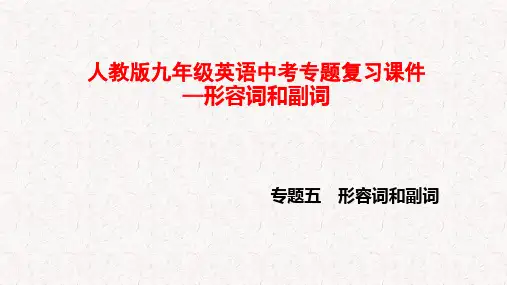
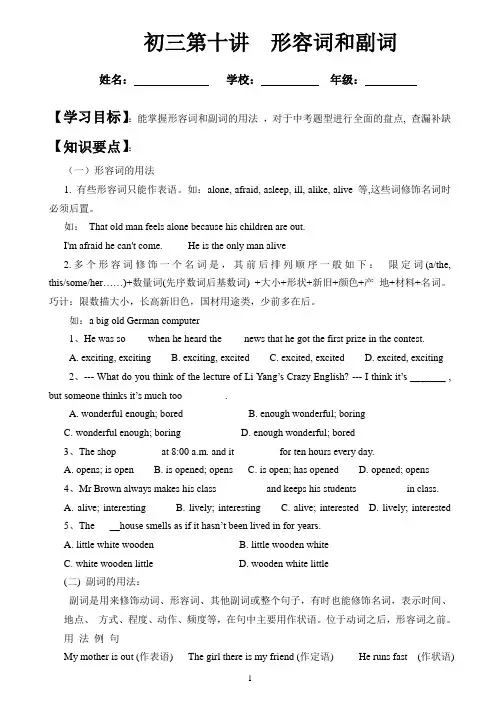
初三第十讲形容词和副词姓名:学校:年级:【学习目标】:能掌握形容词和副词的用法,对于中考题型进行全面的盘点, 查漏补缺【知识要点】:(一)形容词的用法1. 有些形容词只能作表语。
如:alone, afraid, asleep, ill, alike, alive 等,这些词修饰名词时必须后置。
如:That old man feels alone because his children are out.I'm afraid he can't come. He is the only man alive2.多个形容词修饰一个名词是,其前后排列顺序一般如下:限定词(a/the, this/some/her……)+数量词(先序数词后基数词) +大小+形状+新旧+颜色+产地+材料+名词。
巧计:限数描大小,长高新旧色,国材用途类,少前多在后。
如:a big old German computer1、He was so ____when he heard the ____news that he got the first prize in the contest.A. exciting, excitingB. exciting, excitedC. excited, excitedD. excited, exciting2、--- What do you think of the lecture of Li Yang’s Crazy English? --- I think it’s _______ , but someone thinks it’s much too ________.A. wonderful enough; boredB. enough wonderful; boringC. wonderful enough; boringD. enough wonderful; bored3、The shop ________ at 8:00 a.m. and it ________ for ten hours every day.A. opens; is openB. is opened; opensC. is open; has openedD. opened; opens4、Mr Brown always makes his class _________ and keeps his students _________ in class.A. alive; interestingB. lively; interestingC. alive; interestedD. lively; interested5、The_____house smells as if it hasn’t been lived in for years.A. little white woodenB. little wooden whiteC. white wooden littleD. wooden white little(二) 副词的用法:副词是用来修饰动词、形容词、其他副词或整个句子,有时也能修饰名词,表示时间、地点、方式、程度、动作、频度等,在句中主要用作状语。
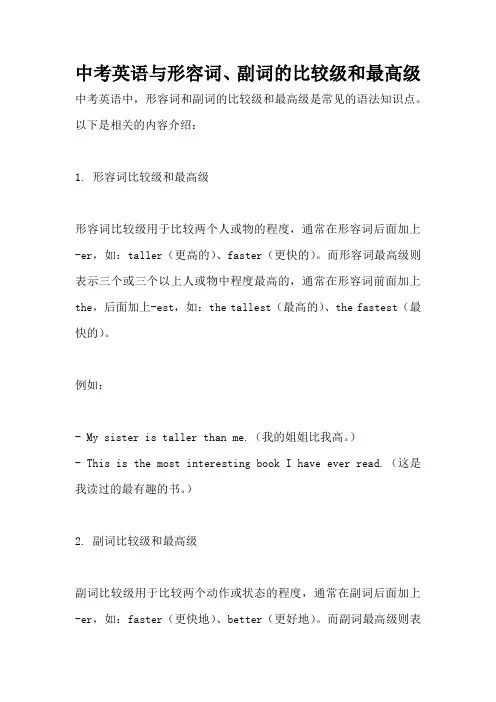
中考英语与形容词、副词的比较级和最高级中考英语中,形容词和副词的比较级和最高级是常见的语法知识点。
以下是相关的内容介绍:1. 形容词比较级和最高级形容词比较级用于比较两个人或物的程度,通常在形容词后面加上-er,如:taller(更高的)、faster(更快的)。
而形容词最高级则表示三个或三个以上人或物中程度最高的,通常在形容词前面加上the,后面加上-est,如:the tallest(最高的)、the fastest(最快的)。
例如:- My sister is taller than me.(我的姐姐比我高。
)- This is the most interesting book I have ever read.(这是我读过的最有趣的书。
)2. 副词比较级和最高级副词比较级用于比较两个动作或状态的程度,通常在副词后面加上-er,如:faster(更快地)、better(更好地)。
而副词最高级则表示三个或三个以上动作或状态中程度最高的,通常在副词前面加上the,后面加上-est,如:the fastest(最快地)、the best(最好地)。
例如:- She sings better than her sister.(她唱歌比她姐姐好。
)- He speaks English the most fluently in our class.(他在我们班上说英语说得最流利。
)需要注意的是,有些形容词和副词的比较级和最高级形式不规则,需要记忆。
例如:- good(好的)- better(更好的)- the best(最好的)- bad(坏的)- worse(更坏的)- the worst(最坏的)- well(好地)- better(更好地)- the best(最好地)- badly(坏地)- worse(更坏地)- the worst(最坏地)。


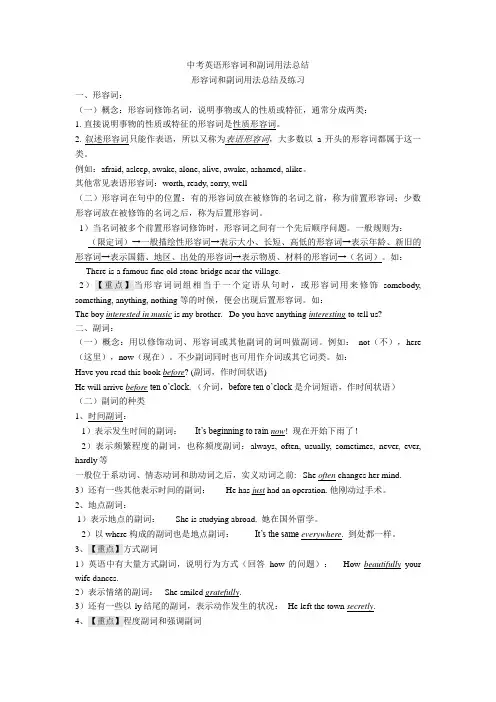
中考英语形容词和副词用法总结形容词和副词用法总结及练习一、形容词:(一)概念:形容词修饰名词,说明事物或人的性质或特征,通常分成两类:1. 直接说明事物的性质或特征的形容词是性质形容词。
2. 叙述形容词只能作表语,所以又称为表语形容词,大多数以a开头的形容词都属于这一类。
例如:afraid, asleep, awake, alone, alive, awake, ashamed, alike。
其他常见表语形容词:worth, ready, sorry, well(二)形容词在句中的位置:有的形容词放在被修饰的名词之前,称为前置形容词;少数形容词放在被修饰的名词之后,称为后置形容词。
1)当名词被多个前置形容词修饰时,形容词之间有一个先后顺序问题。
一般规则为:(限定词)→一般描绘性形容词→表示大小、长短、高低的形容词→表示年龄、新旧的形容词→表示国籍、地区、出处的形容词→表示物质、材料的形容词→(名词)。
如:There is a famous fine old stone bridge near the village.2)【重点】当形容词词组相当于一个定语从句时,或形容词用来修饰somebody, something, anything, nothing 等的时候,便会出现后置形容词。
如:The boy interested in music is my brother. Do you have anything interesting to tell us?二、副词:(一)概念:用以修饰动词、形容词或其他副词的词叫做副词。
例如:not(不),here (这里),now(现在)。
不少副词同时也可用作介词或其它词类。
如:Have you read this book before? (副词,作时间状语)He will arrive before ten o’clock. (介词,before ten o’clock 是介词短语,作时间状语)(二)副词的种类1、时间副词:1)表示发生时间的副词:It’s beginning to rain now! 现在开始下雨了!2)表示频繁程度的副词,也称频度副词:always, often, usually, sometimes, never, ever, hardly等一般位于系动词、情态动词和助动词之后,实义动词之前: She often changes her mind.3)还有一些其他表示时间的副词: He has just had an operation. 他刚动过手术。

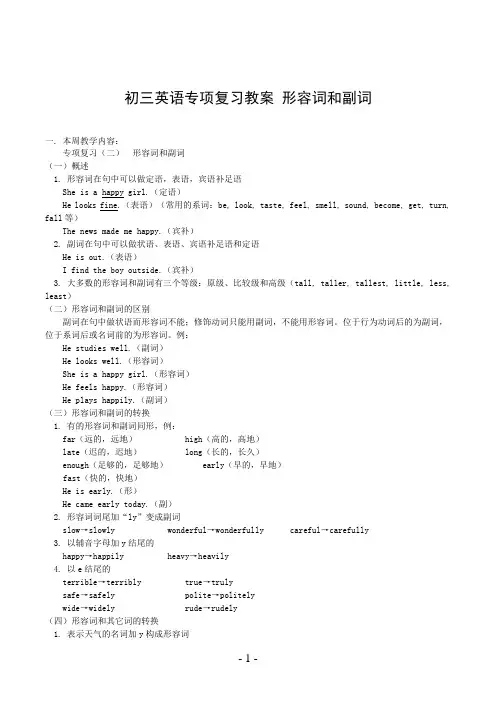
初三英语专项复习教案形容词和副词一. 本周教学内容:专项复习(二)形容词和副词(一)概述1. 形容词在句中可以做定语,表语,宾语补足语She is a happy girl.(定语)He looks fine.(表语)(常用的系词:be, look, taste, feel, smell, sound, become, get, turn, fall等)The news made me happy.(宾补)2. 副词在句中可以做状语、表语、宾语补足语和定语He is out.(表语)I find the boy outside.(宾补)3. 大多数的形容词和副词有三个等级:原级、比较级和高级(tall, taller, tallest, little, less, least)(二)形容词和副词的区别副词在句中做状语而形容词不能;修饰动词只能用副词,不能用形容词。
位于行为动词后的为副词,位于系词后或名词前的为形容词。
例:He studies well.(副词)He looks well.(形容词)She is a happy girl.(形容词)He feels happy.(形容词)He plays happily.(副词)(三)形容词和副词的转换1. 有的形容词和副词同形,例:far(远的,远地)high(高的,高地)late(迟的,迟地)long(长的,长久)enough(足够的,足够地)early(早的,早地)fast(快的,快地)He is early.(形)He came early today.(副)2. 形容词词尾加“ly”变成副词slow→slowly wonderful→wonderfully careful→carefully3. 以辅音字母加y结尾的happy→happily heavy→heavily4. 以e结尾的terrible→terribly true→trulysafe→safely polite→politelywide→widely rude→rudely(四)形容词和其它词的转换1. 表示天气的名词加y构成形容词could→cloudy wind→windy rain→rainysnow→snowy sun→sunny ice→icy(sun,ice比较特殊)2. 一些动词加ful构成形容词care→careful thank→thankful wonder→wonderfulforget→forgetful use→useful help→helpful3. 一些名词加ly变为形容词friend→friendly father→fatherly sister→sisterlymother→motherly love→lovely4. 有些动词后加able变成形容词enjoy→enjoyable comfort→comfortable5. 名词后加ous变成形容词danger→dangerous humor→humorous(五)区别几组易混淆的副词、形容词already常用于肯定句,个别疑问句,yet常用于否定句、疑问句such修饰名词,so修饰形容词、副词The train has already gone.They haven’t come back yet.I have never seen such an interesting film.This box is so heavy that I can’t carry it.alone(单独、独自)作表语=by oneselflonely(孤独的)可作表语、定语He lived alone, but he didn’t feel lonely.他一个人生活但并不觉得寂寞。
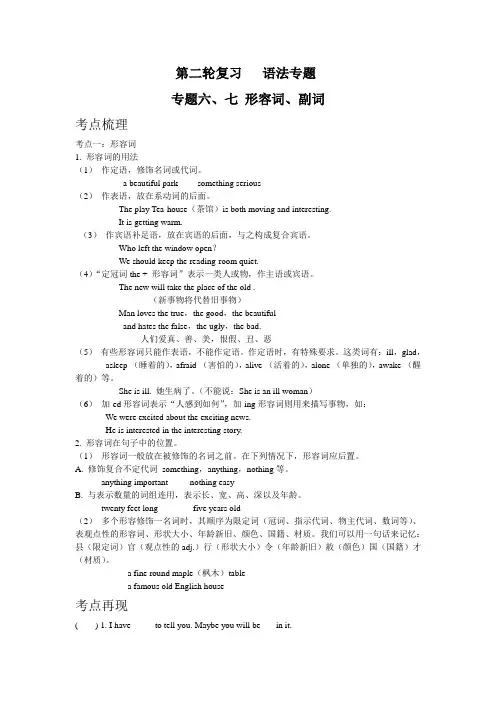
第二轮复习语法专题专题六、七形容词、副词考点梳理考点一:形容词1. 形容词的用法(1)作定语,修饰名词或代词。
a beautiful park something serious(2)作表语,放在系动词的后面。
The play Tea-house(茶馆)is both moving and interesting.It is getting warm.(3)作宾语补足语,放在宾语的后面,与之构成复合宾语。
Who left the window open?We should keep the reading-room quiet.(4)“定冠词the + 形容词”表示一类人或物,作主语或宾语。
The new will take the place of the old .(新事物将代替旧事物)Man loves the true,the good,the beautifuland hates the false,the ugly,the bad.人们爱真、善、美,恨假、丑、恶(5)有些形容词只能作表语,不能作定语。
作定语时,有特殊要求。
这类词有:ill,glad,asleep (睡着的),afraid (害怕的),alive (活着的),alone (单独的),awake (醒着的)等。
She is ill. 她生病了。
(不能说:She is an ill woman)(6)加-ed形容词表示“人感到如何”,加-ing形容词则用来描写事物,如:We were excited about the exciting news.He is interested in the interesting story.2. 形容词在句子中的位置。
(1)形容词一般放在被修饰的名词之前。
在下列情况下,形容词应后置。
A. 修饰复合不定代词something,anything,nothing等。
anything important nothing easyB. 与表示数量的词组连用,表示长、宽、高、深以及年龄。
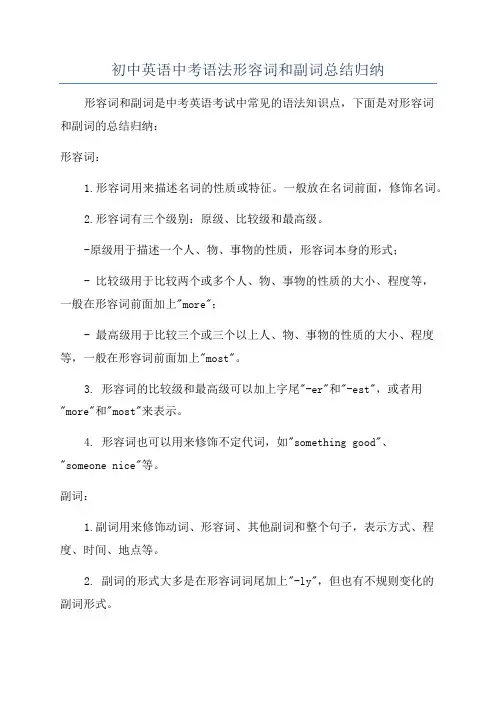
初中英语中考语法形容词和副词总结归纳形容词和副词是中考英语考试中常见的语法知识点,下面是对形容词和副词的总结归纳:形容词:1.形容词用来描述名词的性质或特征。
一般放在名词前面,修饰名词。
2.形容词有三个级别:原级、比较级和最高级。
-原级用于描述一个人、物、事物的性质,形容词本身的形式;- 比较级用于比较两个或多个人、物、事物的性质的大小、程度等,一般在形容词前面加上"more";- 最高级用于比较三个或三个以上人、物、事物的性质的大小、程度等,一般在形容词前面加上"most"。
3. 形容词的比较级和最高级可以加上字尾"-er"和"-est",或者用"more"和"most"来表示。
4. 形容词也可以用来修饰不定代词,如"something good"、"someone nice"等。
副词:1.副词用来修饰动词、形容词、其他副词和整个句子,表示方式、程度、时间、地点等。
2. 副词的形式大多是在形容词词尾加上"-ly",但也有不规则变化的副词形式。
3. 副词有原级和比较级,形式和形容词的比较级一样,可以在副词前面加上"more"来表示。
注意事项:1.形容词和副词的比较级和最高级要根据词的性质和词尾变化,不是所有形容词和副词都可以直接加上字尾来表示比较级和最高级。
2.形容词和副词的用法、位置和修饰的词性有一定的规律,需要具体问题具体分析。
以上是对初中英语中考语法中形容词和副词的总结归纳,希望能够帮助到你。
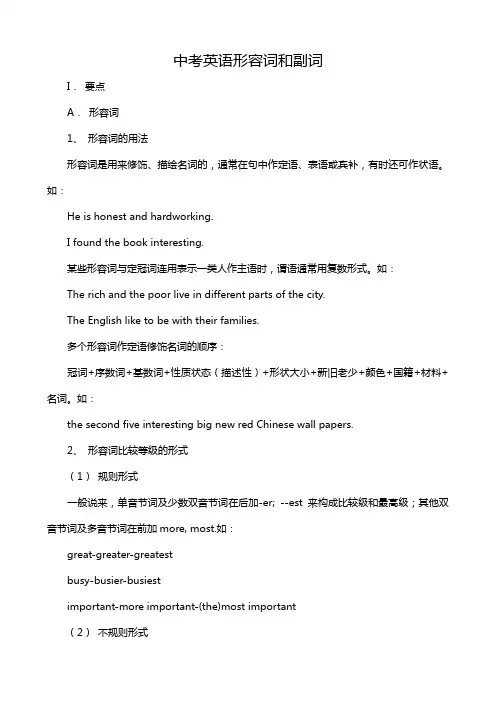
中考英语形容词和副词I.要点A.形容词1、形容词的用法形容词是用来修饰、描绘名词的,通常在句中作定语、表语或宾补,有时还可作状语。
如:He is honest and hardworking.I found the book interesting.某些形容词与定冠词连用表示一类人作主语时,谓语通常用复数形式。
如:The rich and the poor live in different parts of the city.The English like to be with their families.多个形容词作定语修饰名词的顺序:冠词+序数词+基数词+性质状态(描述性)+形状大小+新旧老少+颜色+国籍+材料+名词。
如:the second five interesting big new red Chinese wall papers.2、形容词比较等级的形式(1)规则形式一般说来,单音节词及少数双音节词在后加-er; --est 来构成比较级和最高级;其他双音节词及多音节词在前加more, most.如:great-greater-greatestbusy-busier-busiestimportant-more important-(the)most important(2)不规则形式good (well)-better-bestbad (ill)-worse-worstmany (much)-more-mostlittle-less-least(3)形容词比较等级的用法①表示两者的比较,用形容词的比较级+than. 如:He is cleverer than the other boys.This one is more beautiful than that one.②表示两者以上的比较,用"the +形容词最高级(+名词)+of(in) …"如:He is the cleverest boy in his class.③表示两者是同等程度,用"as +形容词原级+as". 如:He is as tall as I.I have as many books as you.④越…越…例如:The more I learn, the happier I am.⑤You can never be too careful. 越小心越好又如:You can never praise the teacher too highly.你怎么赞扬这个老师也不过分。
形容词、副词比较等级的讲解与用法形容词与副词的比较等级1) 同级比较往往由"as + 形容词/ 副词的原形+ as"的句式表达;当然也要注意它的否定形式、以及在第一个as前加倍数或程度副词的情况。
2)"比较级+ than"引导不同级的比较。
"比较级" 前同样可以加倍数或程度副词。
另外"no more …than"意思是"A和B一样不……" 。
3) 形容词的最高级前一般必须有定冠词the;但是也有不加定冠词the的几种情况。
4) 要注意几种比较级的特殊句型,如:"the + 比较级…,the + 比较级……",意思是"越……越……";以及"比较级+ and + 比较级"意思是"越来越…",等。
英文中的形容词和副词一般都有三种级的形式即:原级(The Positive Degree),比较级(The parative Degree)和最高级(The Superlative Degree)。
5)同级比较中有两种情况:# 表示双方情况"一模一样",用as + 原级+ as的结构;# 表示双方情况"不(那么)一样",用not so / as + 原级+ as的结构。
在这两种结构中,第一个as是副词,而第二个as是连词;在第二个as的后面接名词、句子或代词的主格(一般不要接代词的宾格)。
例如:My parcel is as heavy as yours . 我的包裹与他的一样沉。
Arther calculates as accurately as a calculator.阿瑟象计算器一样计算精确。
His bedroom is not as neat as his sister's. 他的寝室没有他姐姐的整洁。
中考英语词汇之形容词和副词形容词和副词在英语中是非常重要的词类,它们可以用来描述人、事物的性质、状态以及描述动作的方式。
掌握形容词和副词的用法和意义,对于中考英语的考试非常关键。
本文将详细介绍中考英语中形容词和副词的基本知识点。
一、形容词(Adjectives)形容词是用来描述、修饰名词或代词的词类。
它可以描述一个事物的特征、性质、数量或状态。
形容词在句子中通常位于名词之前,用以补充说明名词的特征。
1. 形容词的位置形容词通常放在名词之前,作为名词的修饰语。
例如:- a beautiful flower(一个漂亮的花)- an interesting book(一本有趣的书)2. 形容词的比较级和最高级形容词有原级、比较级和最高级三种形式。
比较级用于比较两个人或物之间的差异,最高级用于比较三个或三个以上人或物之间的差异。
形容词的比较级的构成规则如下:- 单音节形容词和部分双音节形容词在词尾加-er构成比较级,加-est 构成最高级。
例如:- small(小的)- smaller(更小的)- smallest(最小的)- tall(高的)- taller(更高的)- tallest(最高的)- 以字母“e”结尾的形容词,在词尾加-r构成比较级,加-st构成最高级。
例如:- brave(勇敢的)- braver(更勇敢的)- bravest(最勇敢的)- 以辅音字母+y结尾的形容词,将y变为i,再加-er构成比较级,加-est构成最高级。
例如:- happy(幸福的)- happier(更幸福的)- happiest(最幸福的)形容词的最高级的构成规则如下:- 单音节和部分双音节形容词在词尾加-est构成最高级。
- 大部分双音节或多音节形容词在前面加most构成最高级。
3. 常见形容词的用法形容词可以用于修饰人物、事物的外貌、特征、品质等。
例如:- beautiful(漂亮的),表示外貌美丽。
例如:a beautiful girl(一个漂亮的女孩)- tall(高的),表示身材高大。
形容词和副词(2-副词)●副词的构词:1)大部分形容词+ ly = 副词e.g.deep --> deeply ; loud --> loudly2)以y结尾的形容词,改y为i,+ ly = 副词e.g.happy --> happily ; easy --> easily3)以le结尾的形容词,去e,+ y = 副词e.g. possible --> possibly ; reliable --> reliably4)不规则变化e.g. good --> well ; bad --> worse5)有些副词和形容词同形初中考纲中有七个形容词和副词形式相同: ahead; early; fast; hard; high; late; straight The road ahead was blocked.I’ll run ahead.The early part of her life was spent in Paris.I get up early everyday.He is a fast learner.The water was rising fast.Diamonds are hard.You must try hard.I looked down from the high window.We should aim high and do our best to achieve our goal.She is late for work everyday.I got up late.He was too tired to walk straight.You look better with straight hair.●副词的用法副词在句中用作状语。
e.g.It's raining hard.Don’t drive too fast.This is a fairly useful tool.Luckily, he still got first prize.●副词的位置1)方式状态的副词(Adverbs of Manner)这一类副词是修饰动词专用的,典型拼法是形容词加上-ly。
1.形容词和副词的比较级和最高级:比较级和最高级的形成规则:形容词和部分副词在原级后加上-er或-est,如taller、the tallest;以-y结尾的形容词变-y为-i再加上-er或-est,如 happier、the happiest;以辅音字母加'y'结尾的重读闭音节词要双写最后一个辅音字母再加上-er或-est,如bigger、the biggest。
部分形容词的比较级和最高级不规则变化,如good-better-best、bad-worse-worst。
2.形容词和副词的用法:形容词用来修饰名词,用于句子的主语、宾语、定语和表语等成分中;副词用来修饰动词、形容词和其他副词,用于句子的状语中。
3.反义词的用法:反义词(Antonyms)指的是意义相反的词,如big-small、tall-short。
在句子中常常使用这些反义词来表达对比的含义。
4.数词和量词的用法:数词用来表示具体的数量,有基数词和序数词之分;量词用来表示不具体的数量,如some、a few、a little等。
5.常见疑问词的用法:常见的疑问词有who、whom、whose、what、which、when、where、why和how等,它们用来引导疑问句,表示询问人、事、地点、原因、方式等。
6.句型转换:7.形容词性物主代词:形容词性物主代词用来表示所属关系,如my、your、his、her、its、our和their等。
8.形容词修饰不定代词:形容词可以修饰不定代词,如some、any、no、every和both等。
9.特殊疑问句和特殊疑问词:10.特殊句型之一般现在时态的句子:一般现在时态用来表示经常性的动作、习惯和真理,谓语动词用原形。
以上就是九年级英语第三单元的重要知识点。
掌握了这些知识点,对于理解和运用这一单元的语法和词汇会有很大帮助。